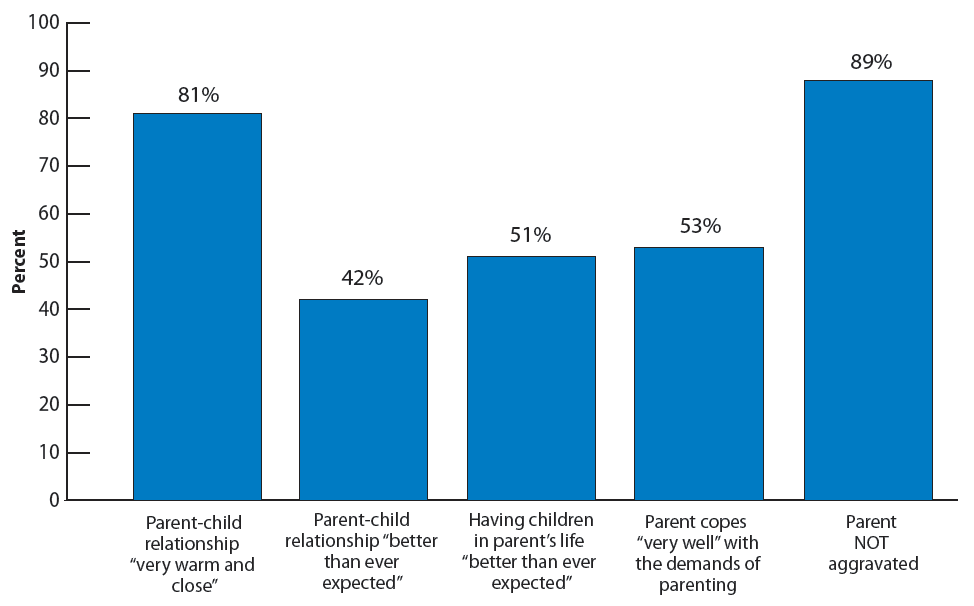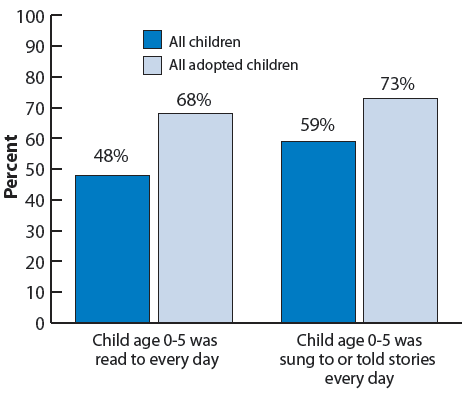

 Most adopted children fare well, according to six measures of
socio-emotional well-being, but a small minority experience serious
problems. Parents’ responses indicate that the majority of adopted children
have never been diagnosed with each of the four psychological disorders included
in the survey. Twelve percent of adopted children have ever been diagnosed with
attachment disorder. The survey did not ask about the severity of the disorder.
Most adopted children diagnosed with attachment disorder have parents who report
a “very warm and close” relationship with their child, although such reports are
rarer than among adopted children without attachment disorder (64 compared with
84 percent). Overall, 4 percent of adopted children both have been diagnosed
with attachment disorder and have a parent who reported the relationship as not
being very warm and close.
Most adopted children fare well, according to six measures of
socio-emotional well-being, but a small minority experience serious
problems. Parents’ responses indicate that the majority of adopted children
have never been diagnosed with each of the four psychological disorders included
in the survey. Twelve percent of adopted children have ever been diagnosed with
attachment disorder. The survey did not ask about the severity of the disorder.
Most adopted children diagnosed with attachment disorder have parents who report
a “very warm and close” relationship with their child, although such reports are
rarer than among adopted children without attachment disorder (64 compared with
84 percent). Overall, 4 percent of adopted children both have been diagnosed
with attachment disorder and have a parent who reported the relationship as not
being very warm and close.Before and after our decision to adopt, we have spoken with several adoptive parents of children who were adopted from age 6 months to 7 years. Many adopted more than one child. Most reported no attachment issues. A few reported mild issues with the younger ones (age 1) than with the older children. Older children were so excited to have a mommy and daddy. One mother (and social worker) told me, "My daughter spent the first three years of her life in an orphanage. I adopted her at age four. When I arrived to meet her for the first time at the foster home, she was waiting for me on the steps. She reached out her arms and let me hold her. She wouldn't let go. She never looked back. She was mine and she knew it. She remembers nothing of her life before me and we have no attachment issues at all." Her daughter is now almost 10. On the other hand, I have heard from people about attachment disorder with a baby that was adopted at 6 weeks old. The point is, it is always a possibility, but it is not the norm. There are also great resources, intentional parenting techniques, and lots of positive science dealing with rebuilding positive brain connections for a child that experienced a less than optimal start in life. We plan on (and are) educating ourselves on the subject but will never let fear be the ruling force in our life decisions. Yes, it is a scary subject. We have dealt with a few of those already. There are no guarantees that adoption is easy, in fact, you can pretty much bank on it NOT being easy. But it's worth it. They are worth it. It seems most of them realize it too.
Source:http://aspe.hhs.gov/hsp/09/nsap/chartbook/chartbook.cfm?id=13



No comments:
Post a Comment